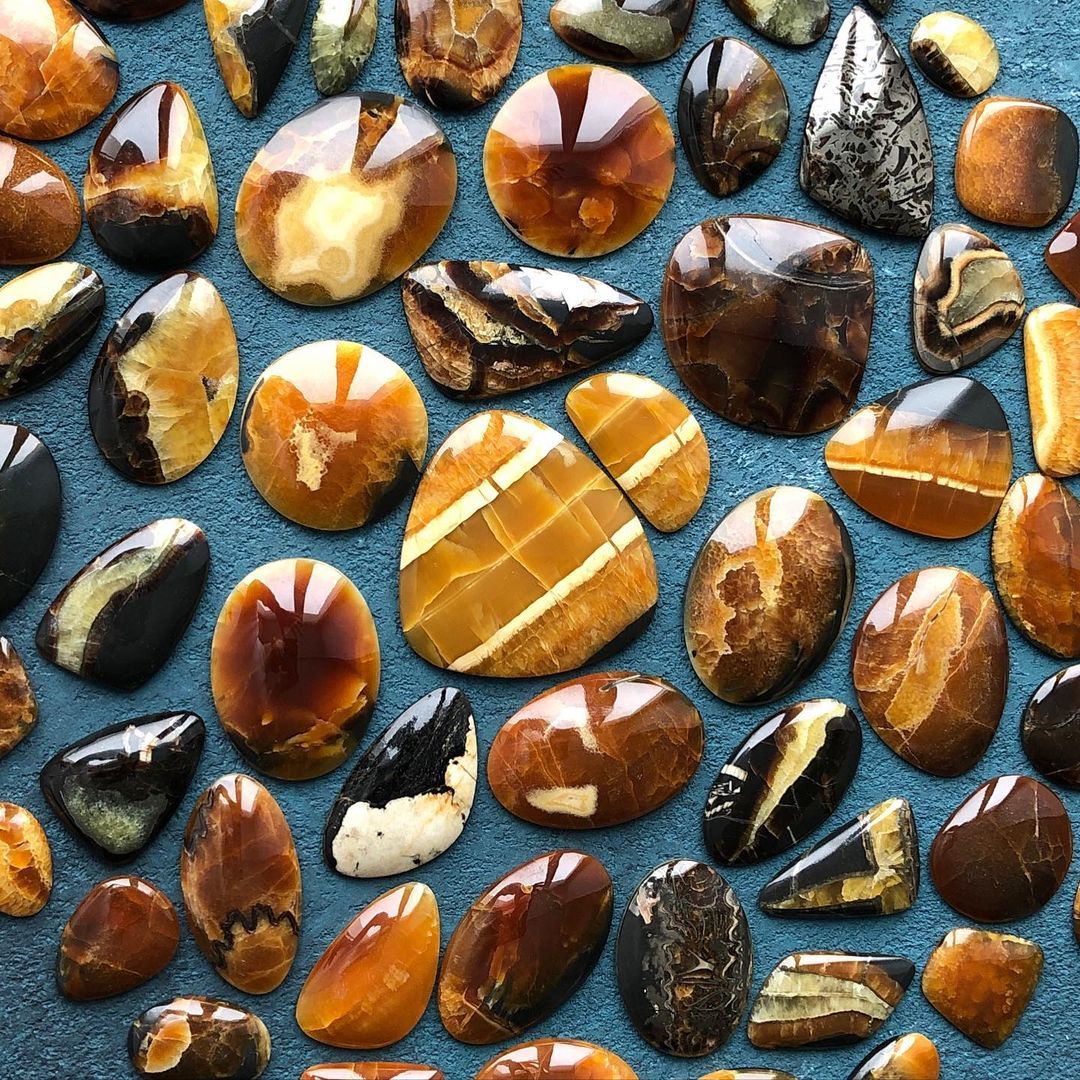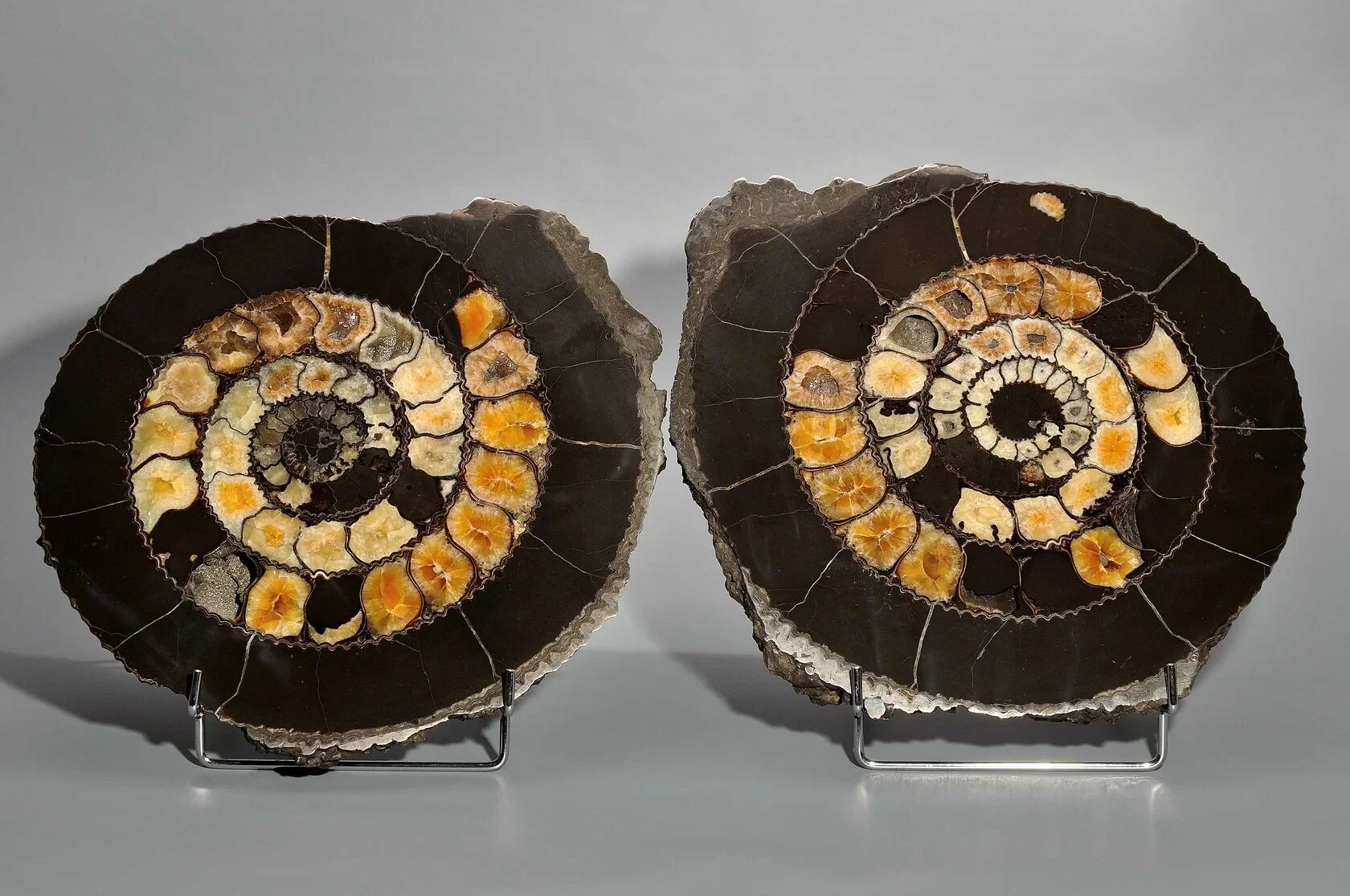the place where Paleontology and Paleoanthropology meets Philately
Russia
Prehistoric animals, fossils, paleontologists and
contributors to Paleontology science, Natural History Museums on stamps
postal stationeries and postmarks of Russia
| << previous country | back to index | next country >> |
Contents:
- Country overview
- Philately of Russia
- Official stamps of Russia related to Paleontology
- Other stamps of Russia to consider
- Postal stationeries of Russia related to Paleontology
- Other postal stationeries of Russia to consider
- Commemorative covers of Russia related to Paleontology
- Other commemorative covers of Russia to consider
- Commemorative postmarks of Russia related to Paleontology
- Other commemorative postmarks of Russia to consider
- References
- Acknowledgements
Russia, officially known as the Russian Federation, is a federal state in Eurasia.
Covering an area of 17,125,200 square kilometres, it is the largest country in the world by area, spanning more than one-eighth of the Earth's inhabited land area, stretching eleven time zones, and bordering 16 sovereign nations (listed counter clockwise around Russia): Norway, Finland, Estonia, Latvia, Lithuania, Poland, Belarus, Ukraine, Georgia, Azerbaijan, Kazakhstan, China, Mongolia, North Korea, Japan, USA.
Following the Russian Revolution in 1917, the Russian Soviet Federative Socialist Republic became the largest and leading constituent of the Union of Soviet Socialist Republics (USSR), the world's first constitutionally socialist state.
Following the partition of the Soviet Union in 1991, fourteen independent republics emerged from the USSR; as the largest, most populous, and most economically developed republic, the Russian SFSR reconstituted itself as the Russian Federation and is recognized as the continuing legal personality and sole successor state of the Soviet Union. [R1]
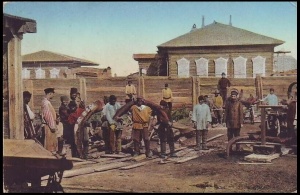
Mammoth tusks transportation from Yakutska, Siberia on postcard of Russia 1910-1917 |
One such postcard, printed between 1910 and 1917 by company of Kornitsky Ya. A, shows preparation of some mammoth tusks and bones for transportation from a Siberian village, near Yakutsk. (example of a used postal card here).
Mammoth bones, especially tusks, was a subject for trade between Russia and China since XVII century.
Postage stamps of the USSR were issued in the period 1923 to 1991. They bore the specific inscription Russian: "Почта СССР" ("Post of the USSR"). [R2]
The Russian Federation has issued stamps since 1992. These stamps are inscribed with the country’s name in both Russian and English.
The Russian spelling is "ROSSIJA" (РОССИЯ"), while the English name has evolved over time.
Initially, Rossija was used as a Russian transcription into English. From 2007 on, the stamps were inscribed with “Russia”.
In the early years after collapse of the USSR, many dealers used the chaos to produce "local" stamps with topical overprints on old Soviet stamps for every possible subject including dinosaurs: Chechenia, Sakhalin, Buriatia, Tuva etc.
On February 24th, 2022 Russian army invaded Ukraine territory and currently bombing peaceful cities and killing civilians all over the territory of Ukraine.
Please think twice if you want to buy anything from Russia, even some stamps or covers, and indirectly support their aggression against Ukraine, free and independent European country.

 |
I'm, Michael Kogan admin and owner of this website, call all my visitors from around the world to boycott Russia - don't give your money to the country to kill Ukrainian citizens and destroy Ukrainian cities.
Official stamps of Russia related to Paleontology: prehistoric animals.
| 03.06.2020 "Paleontologic Heritage of Russia" [1] | 06.05.2022 "Centenary of K. Timiryazev State Biological Museum in Moscow" [Boycott Russia] | 17.02.2023 "Fauna of Russia. Mammoth fauna" [Boycott Russia] |
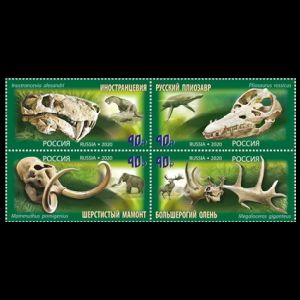 |
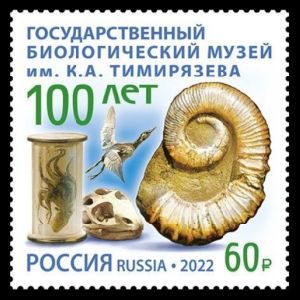 |
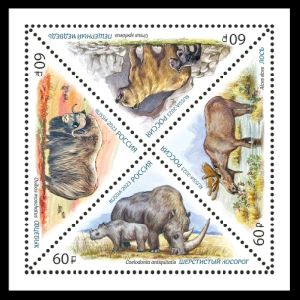 |
| 10.11.2023 - Russia Boycott Russia [2] | ||
 |
||
Notes:
[1] The first set of stamps of Russia dedicated to prehistoric animals ever.
The set of 4 stamps "Paleontologic Heritage of Russia" issued in a Mini-Sheet format with two sets on it and the set title above.
These stamps shows a large variety of prehistoric animals from different eras of the Earth's geological history that have been found in rocks in the territory of modern-day Russia (include occupied territories - Crimean Peninsula [PM1]).
The postal stamps provide images of fossil remains and reconstructed images of Inostrancevia, Pliosaurus rossicus, the woolly mammoth (Mammuthus primigenius) and the Megaceros giganteum.
There are also 6 postmarks associated with these stamps - all have the same design of Ammonite, but introduced in 6 different cities of Russia: Moscow, St. Petersburg, Saratov, Yaroslavl, Sevastopol [PM1] and Orenburg.
[2] On November 10th, 2023, Russian Post issued the set of Souvenir-Sheets with stamps from "Paleontologic Heritage of Russia" from 2020 and "Fauna of Russia. Mammoth fauna", issued earlier this year.
Other stamps to consider: fossil sites, Natural History Museums, prehistoric animals as art objects.
| 15.07.1997 "Russian Regions" [A1] | 30.07.2012 "Modern Art of Russia" [A2] | 21.05.2009 "History of Russian State. The 300th anniversary of birth Ekaterina 1 Alekseevna, Russian Queen" [A4] |
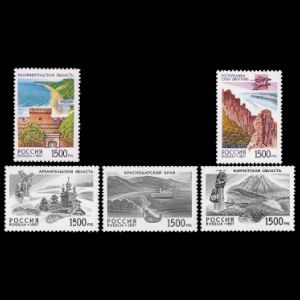 |
 |
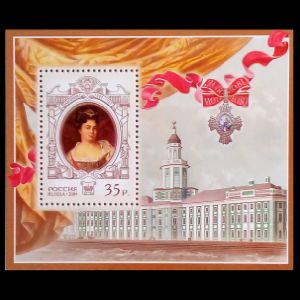 |
| 10.02.2015 "Lena Pillars Nature Park" [A3] | 16.09.2016 "Coats of arms of subjects and cities of the Russian Federation. Perm region" [A6] | 10.07.2017 "Coats of arms of subjects and cities of the Russian Federation. Kaliningrad region" [A1] |
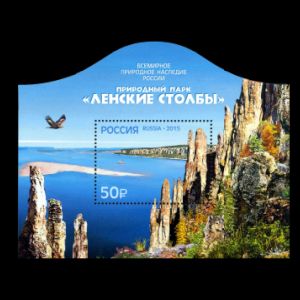 |
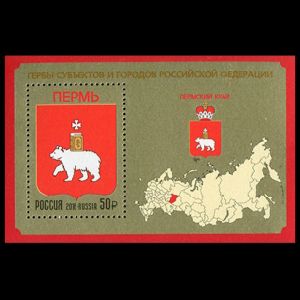 |
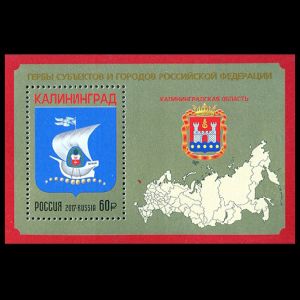 |
| 07.04.2021 "Coats of arms of subjects and cities of the Russian Federation. Kaliningrad region" [A1] | 22.07.2022 "100th Anniversary of the Republic of Sakha (Yakutia)" [A5] | 15.05.2023 "300th Anniversary of Perm city" [A7] |
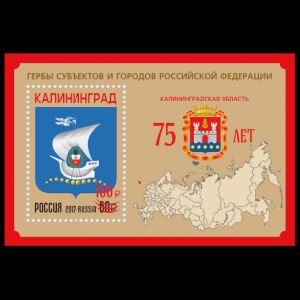 |
 |
 |
| 15.05.2023 "300th Anniversary of Perm city", Surcharged Souvenir-Sheet "Coats of arms of subjects and cities of the Russian Federation. Perm region" [A6] | ||
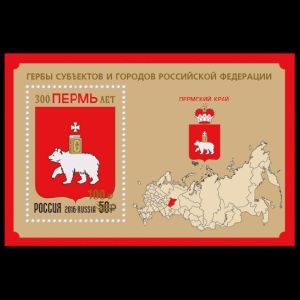 |
|
|
Notes:
[A1] Two stamps of the set of "Russian Regions" are related to Paleontology.
One stamp shows famous Lena Pillars, also shown on a block from 2015 (see above).

|
| Amber Museum in Kaliningrad on postal stationery of USSR 1987. |
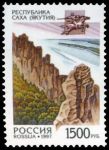
|
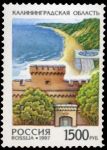
|
| Fossil found place on stamp of Russia 1997 MiNr.: 605, Scott: 6401 | Amber Museum in Kaliningrad on stamp of Russia 1997 MiNr.: 606, Scott: 6399 |
Another stamp shows Kaliningrad Regional Amber Museum, also shown on some postal stationery of USSR. [R12]
Amber is fossilized tree resin, which has been appreciated for its color and natural beauty since Neolithic times.
Much valued from antiquity to the present as a gemstone, amber is made into a variety of decorative objects.
Amber is used as an ingredient in perfumes, as a healing agent in folk medicine, and as jewelry.
Sometimes small prehistoric animals, solidified insects and parts of plants are found in the transparent amber.
Some of them are even shown on post stamps, Poland 1993 and Lithuania 2009 for example.
[A2] On 30 July 2012 Russian post issued 6 stamps, continuing series of "Modern Art of Russia".
The series was begun in 2011. These stamps show some pictures and monuments created by modern Russian artists.
Among them is a stamp depicting Monument Mammoth in Khanty-Mansiysk (the capital of Ugra region).
On September 9, 2007, when the city celebrated its 425th anniversary, Khanty-Mansiysk became a new landmark, while the citizens have a new rest area - sculpture composition of "Mammoths".
Later on, more supplemental figures of primitive humans and other animals added, changing the park into a unique Ice Age park. Now it is referred to as an “Archeopark” with many other figures of prehistoric animals and early humans.
More details are here
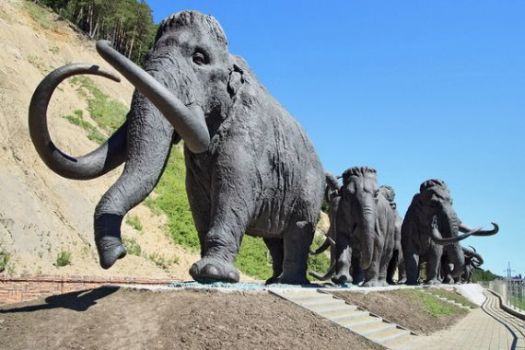 |
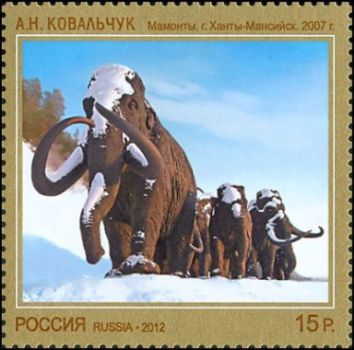 |
| Mammoths sculpture in Khanty-Mansiysk |
Mammoths sculpture in Khanty-Mansiysk on stamp of Russia 2012. MiNr.: 1847, Scott: 7387 |
[A3] Lena Pillars - the name given to a natural rock formation along the banks of the Lena River in far eastern Siberia.
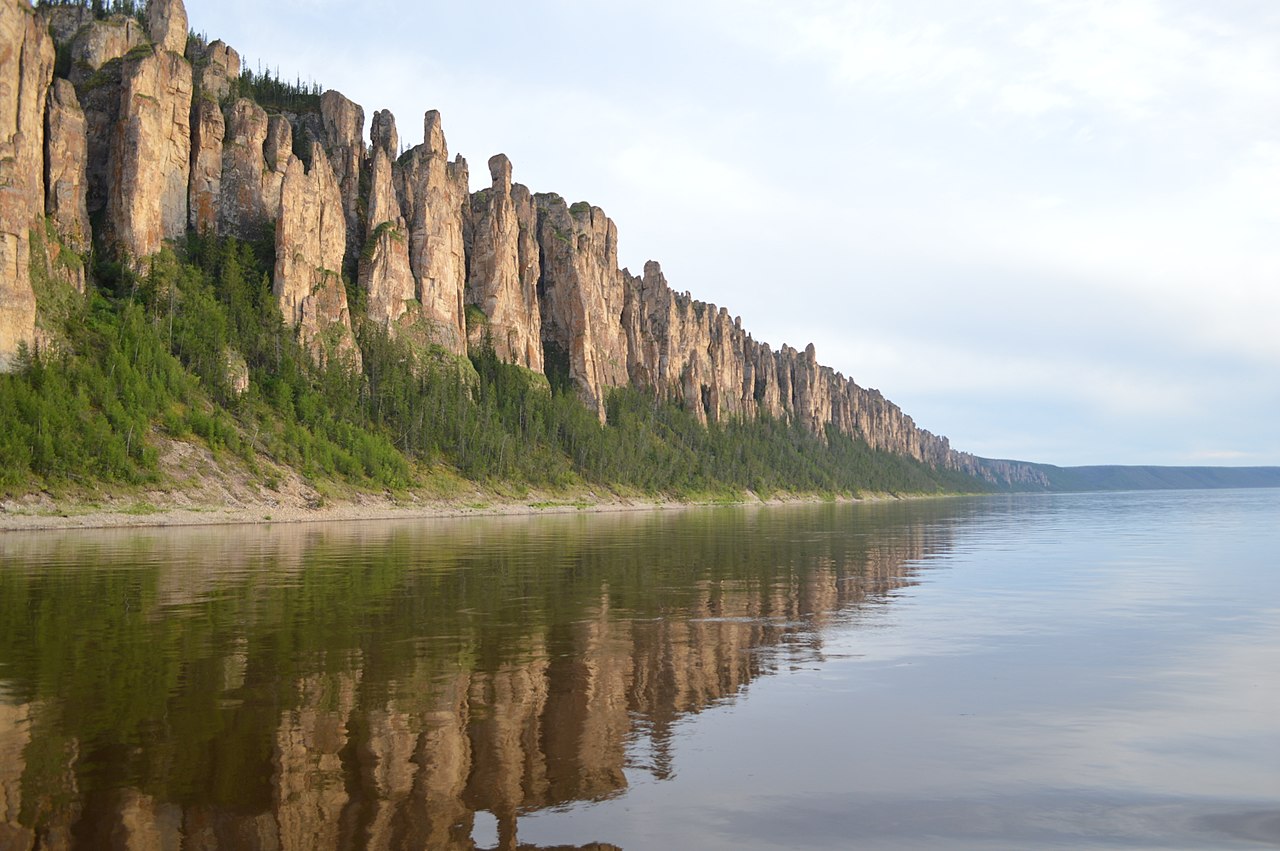
|
| Lena Pillars. Image credit: Wikipedia. |
The park received its name from a unique ridge of rocks in the form of pillars and towers
some up to 100 meters high that stretch along the Lena for tens of kilometers.
These area composed of Cambrian limestone rock formed more than 500 million years ago.
Diring-Yuryakh is a major archaeological site about 60km upriver from
Yakutsk, located very close to the pillars.
In 1982, evidence of man dating back 1-2 million years was discovered here, putting the site
on a par with Professor Leakey’s excavations in Africa.
This site challenges the assumption that the birthplace of humanity was on the African continent.
Yakutsk’s scientists have proposed that the discovery of the world’s oldest stone
scrappers at Diring-Yuryakh proves that the local indigenous people
were the first to adopt tools following the Ice Age which started in the region.
[R11]
[A4] The Kunstkamera [PSO6] - the first Natural History Museum in Russia, shown on the margin of this Souvenir block.
[A5] Mammoth sculpture deppicted on the bottom side of the margin of the Souvenir Sheet. The statue located at the entrance of the Permafrost Institute in Yakutsk. [boycott] [PSO1]
[A6] Perm (Russian: Пермь), previously known as Yagoshikha (Ягошиха) (1723–1781), and Molotov (Молотов) (1940–1957), is the largest city and the administrative centre of Perm Krai (region), Russia. The city is located on the banks of the Kama River, near the Ural Mountains, and has a population of over one million residents.
In 1723, a copper-smelting work was founded in the village of Yagoshikha. In 1781 the settlement of Yagoshikha became the town of Perm. Perm's position on the navigable Kama River, leading to the Volga, and on the Siberian Route across the Ural Mountains, helped it become an important trade and manufacturing center.
The geologic period of the Permian, last period the Paleozoic Era, takes its name from the region name. The Permian Period derives its name from the Russian region of Perm, where rocks deposited during this time are particularly well developed.
The Permian Period began 298.9 million years ago and ended 252.2 million years ago, extending from the close of the Carboniferous Period to the outset of the Triassic Period.
The concept of the Permian was introduced in 1841 by geologist Sir Roderick Impey Murchison, who named it after the region.Murchison (1792-1871), was Scottish geologist, who served as director-general of the British Geological Survey from 1855 until his death in 1871. He is noted for investigating and describing the Silurian, Devonian and Permian systems.
Based on explorations in Perm Krai undertaken with Edouard de Verneuil, Murchison gave to the last period of the Paleozoic Era the name of Permian. [R19][A7] Lore Museum of Perm city shown on the left side of the stamp. The museum has several branches distributed all over the city. One of them is "Museum of Perm Antiquities" which contains a rich collection of fossils collected in the region. These fossils are of different ages from Permian reptiles to Pleistocene mammals, including "Permian Mammoth" (Mammuthus primigenius). [R20]
Postal stationeries of Russia related to Paleontology: fossils, prehistoric animals, paleontologists
| 1994 "100th anniversary of A.I. Oparin" [PS1] | 1997 "150th anniversary of A.P. Karpinskiy" [PS2] | 14.07.2011 (printed 14.07.2011) "270th anniversary of Peter Simon Pallas" [PS4] |
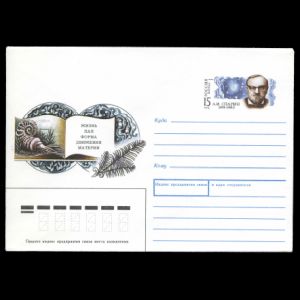 |
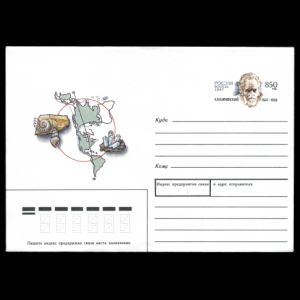 |
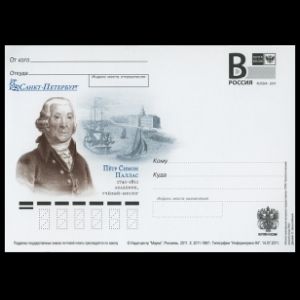 |
| 16.09.2016 (printed 12.09.2016) "275th anniversary of Peter Simon Pallas" [PS4] |
05.12.2016 (printed 15.11.2016) "100th anniversary of Paleontological society of Russia" |
29.11.2017 (printed on 30.10.2017) "175th anniversary of P.A.Kropotkin" [PS3] |
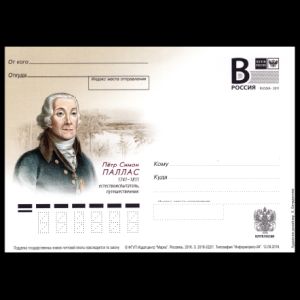 |
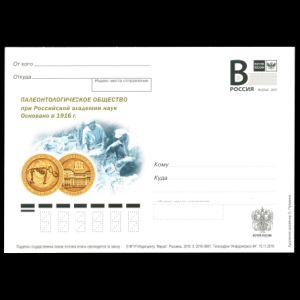 |

|
| 20.04.2022 "State Darwin Museum in Moscow" [boycott] | ||
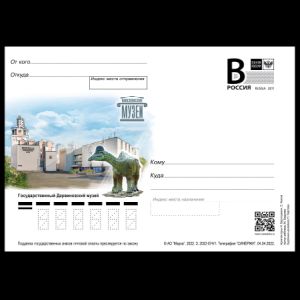 |
|
|
Notes:
[PS1] Alexander Ivanovich Oparin (March 2, 1894 – April 21, 1980) was a Soviet biochemist notable for his theories about the origin of life, and for his book "The Origin of Life".
While Oparin himself was unable to conduct experiments to test any of these ideas, later researchers tried. [R3]
In 1953, Stanley Miller attempted an experiment to investigate whether chemical
self-organization could have been possible on pre-historic Earth.
The Miller–Urey experiment introduced heat (to provide reflux) and electrical energy (sparks, to
simulate lightning) into a mixture of several simple components that
would be present in a reducing atmosphere.
Within a fairly short period of time a variety of familiar organic compounds, such as amino acids,
were synthesised.
The compounds that formed were somewhat more complex than the molecules present at the beginning of the experiment.
[R13]
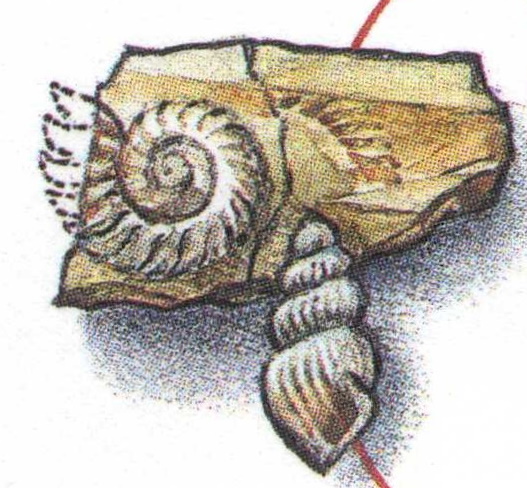
|
| Helicoprion jaw on cachet of postal stationery of Russia 1997 |
[PS2] Aleksandr Karpinsky (1847 - 1936) USSR most known as First elected president of Russian Science Academic.
However, he was also a great geologist and paleontologist, who made some important discoveries in the Ural Mountains area of Russia. [R14]
The map as well as some minerals and fossils shown on the illustration of the cover.
In 1899, for example, he described new bizarre species of prehistoric fish Helicoprion based on a fossil jaw
found in limestones of the Ural Mountains.
Helicoprion is a genus of extinct, shark-like eugeneodontid holocephalid fish, who had
spirally arranged clusters of the individuals' teeth, called "tooth whorls"— the cartilaginous skull,
spine, and other structural elements have not been preserved in the fossil record,
leaving scientists to make educated guesses as to its anatomy and behaviour.
Helicoprion lived in the oceans of the early Permian 290 million years ago,
with species known from North America, Eastern Europe, Asia, and
Australia [R18].
[PS3] To the 175th anniversary since the birth of the scientist and philosopher P.A. Kropotkin, Post authority of Russia issued the postal stationery and two postmarks with his portrait: one from Moscow and another from St. Petersburg.
Kropotkin Pyotr Alekseyevich (1842-1921) was a geographer, geologist and traveler. He did research in Siberia and Priamurye. He was one of the founders of paleogeography of the Anthropogene and suggested the idea that the continents had been glaciated including suggesting that the Pleistocene was characterized by an ice age. He also developed alternative theories of evolution based on embryology. He travelled in eastern Siberia and Manchuria from 1863 until 1867, and his subsequent publications about that area's geography became authoritative until the middle of the twentieth century.
Kropotkin argued that his geographic and geologic observations in Asia, Finland, Sweden, and Canada, supported the theory of Pleistocene continental glaciation, often called the ice age.
Though the Swiss geologist Agassiz had proposed this a few decades earlier based on his work in North America and Europe.
He was one of the first to study the ancient geography and climate of the Quaternary period, which spans from 2.5 million years ago until the present.
Around the turn of the nineteenth century, Kropotkin offered what he said were complementary amendments to Charles Darwin's 1859 theory of evolution by natural selection.
Kropotkin employed a variety of arguments from natural history, embryology, and geography to support his theory of mutual aid, which he argued was a positive mechanistic addition to the theory of evolution. [R4]
[PS4] Peter Simon Pallas (1741–1811), the outstanding naturalist of German origin, became a veteran and honourable member of the Sankt-Petersburg Academy of Sciences.
A part of his great activity was devoted to paleontological research on animals of the “mammoths fauna”.
During two long expeditions in the Russian Empire he recognized and described many fossils. Particularly, he was the first scientist, who received and described some remains of extinct animal with soft parts preserved in permafrost of Siberia. He introduced formal binomial nomenclature and Linnean taxonomy to Russia, and named many species including: Rhinoceros lenensis (rhino), Nautilites complanatus (early Cretaceous ammonite), Cardium trigonoides (subfossil bivalve), Eschara lapidosa (Miocene bryozoan).
It is accepted that, the Russian paleontological science on the permanent basis has originated from the works of Pallas.
[R15]
Some other postal stationery of Russia to consider: Natural History Museums, contributors to Paleontology science, prehistoric animals as art objects, amber etc.
| 1994 "270 years of Russian Science Academy" [PSO6] | 1999 "275 years of Russian Science Academy" [PSO6] | 2001 "Amber museum of Kaliningrad" [A1] |
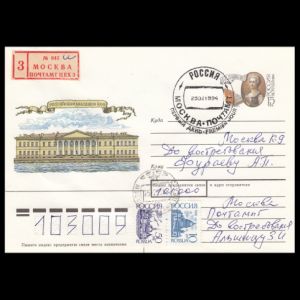 |
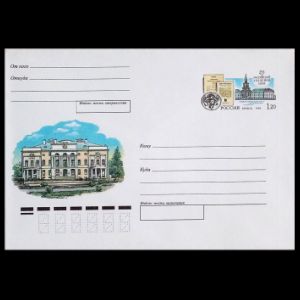 |
 |
| 2001 "Permafrost research station in Yakutia" [PSO1] | ||
 |
|
|
| 23.12.2005 "Saint Petersburg. Museum of Anthropology and Ethnography. Peter the Great (Kunstkamera)." [PSO6] | 09.01.2007 (printed 28.09.2006) "125th anniversary of AP Karpinsky Russian Geological Research Institute" [PSO2] |
24.05.2007 (printed 01.03.2007) "175th anniversary of Zoological Institute of Russian Science Academy in St. Petersburg" [PSO3] |
 |
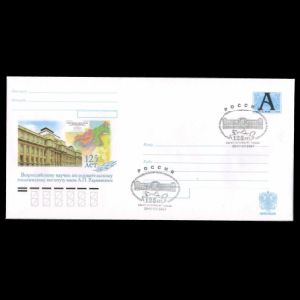 |
 |
| 29.04.2008 (printed 23.01.2008) "360th anniversary of Ulyanovsk (former Simbirsk) city" [PSO4] |
22.07.2013 (printed 20.06.2017) "150th anniversary of V.A. Obruchev" [PSO5] |
06.06.2014 (printed 12.05.2017) "300th anniversary of Kunstkamera" [PSO6] |
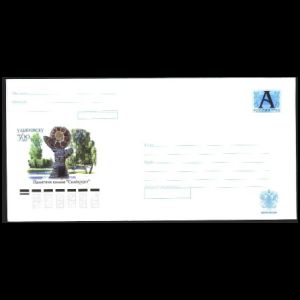 |
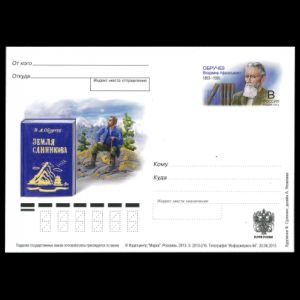 |
 |
| 12.08.2014 (printed 06.06.2014) "300th anniver+sary of Kunstkamera" [PSO6] |
16.06.2016 "VI Children of Asia International Sports Games" [PSO1] | |
 |
 |
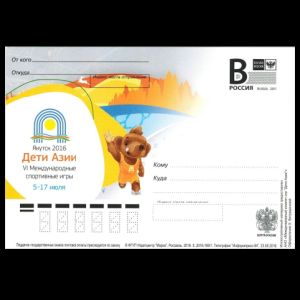 |
| 30.06.2016 "Football Eurocup 2016 in Russia, Kaliningrad" [PSO7] | 17.08.2016 (printed 19.05.2016) "Football Eurocup 2016 in Russia, Kaliningrad" [PSO7] |
27.02.2017 (printed 10.02.2017) "225th anniversary Karl Maksimovich Baer (1792-1876), co-founder of the Russian Geographical Society" [PSO9] |
 |
 |
 |
Notes:
[PSO1] The Mammoth monument, designed by Soviet artist Lev Georgievich Adonin, installed in 1972 in the middle of a fountain in the front of Permafrost Research Institute in Yakutsk, Russia.
The artist worked together with the Institute staff to create as realistic as possible model.
Nowadays it is one of the most popular sightseeing locations in Yakutsk.
The Permafrost Institute, was founded in 1960, is a member institution of the Siberian Branch of Russian Academy of Sciences, and is dedicated to basic and applied investigations in two broad areas:
- permafrost evolution in relation to natural and anthropogenic factors
- thermal and mechanical interactions between engineering structures and permafrost
Mammoth sculpture from Yakutsk can be seen on background of the postal stationery .
[PSO2] Paleontological Society, which celebrated its 100th anniversary in 2016, belongs to the Institute. [R6]

|
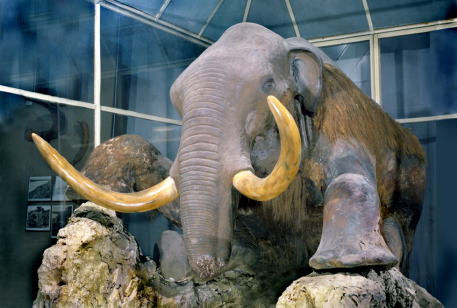
|
| both images above are from official website of the Zoological Museum of the Zoological Institute of the Russian Academy of Sciences. |
[PSO3] The Zoological Museum of the Zoological Institute of the Russian Academy of Sciences is a Russian museum devoted to zoology.
It is located in Saint Petersburg, on Universitetskaya Embankment and it is one of the ten largest nature history museums in the world.
The museum was established in 1832 by split of zoological collection from Kunstkamera museum.
The most famous exhibit of paleontological collection is Mammoth collection.
One of the mammoths is shown on the logo of the museum and is depicted on illustration of the postal stationery.
The logo shows а scarecrow of the Berezovsky mammoth - it is a unique specimen of an adult male woolly mammoth that is well preserved in permafrost.
It is named after the Berezovka River, on the banks of which it was found. [R7]
[PSO4] Simbircite is rare gemstone, which is extracted in only few fields in the world, mostly on the banks of the Volga river at Ulianovsk city. It is also, informally, called "River Volga Amber".
Simbercite (also Simbircite) is named after the Russian city of Simbirsk (now Ulianovsk).
The earliest records of this gemstone date back to 1765, but it wasn’t until 1985 that the mineral was named.
Simbercite is a gemstone is made up of a composite of golden marble onyx, orange aragonite or calcite,
black marl, nacre (mother of pearl), pyrite, marl, and a number of other minerals in smaller quantities.
Chemically it is dominated by the carbonate minerals (aragonite, calcite, nacre) and has a chemical composition of CaCO3.
These minerals can be found as separate minerals all over the world – the uniqueness of simbercite is that these gemstones
combine to form a very unique mineral aggregate at this site in Russia.
It has similar properties to Amber (petrified tree sap) and Carnelian – they are soft gemstones that take a gorgeous polish.
Due to the specific geological conditions, these gemstones formed from alteration of marine sediments and fossils.
Spectacular fossils of ammonites are found with simbercite filling the chambers of ammonoids.
In rarer cases, bones of ichthyosaurs, plesiosaurs, and pliosaurs have been found where the centers have been
dissolved out and replaced with simbercite.
A second type is vein-filling simbercite – in this case, the simbercite fills fractures in the
rock giving the rock an amber-hued network of veins.
The pedestal is made from fragments of a Jurassic plate. The shell is cast from a special composition with inlaid with symbirate. [R16]
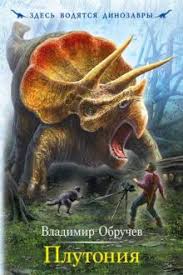
|
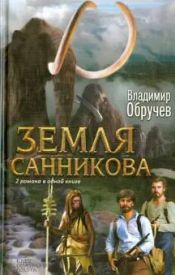
|
| Modern edition of "Plutonia" book of Vladimir Obruchev. | Modern edition of "Sannikov Land" book of Vladimir Obruchev |
Many of his works deal with the origins of loess in Central Asia and Siberia, ice formation and permafrost in Siberia, problems of Siberian tectonics, and Siberian goldfields.
He was also one of the first Russian science fiction authors.
In Russia Obruchev is best known as the author of two perennially popular
science fiction novels, "Plutonia" (1915) and "Sannikov Land" (1924).
Both of these stories, imitating the pattern of Arthur Conan Doyle's "The Lost World",
depicting in vivid detail the discovery of an isolated world of prehistoric animals in hitherto
unexplored large islands north of Alaska or Siberia.
His descriptive passages are made more credible by Obruchev's extensive
knowledge of paleontology. "Sannikov Land" is named for a phantom
island of the Arctic Ocean, reported historically by Yakov Sannikov in 1811.
[PSO6] The Kunstkamera is the first museum in Russia.
Established by Peter the Great and completed in 1727, the Kunstkammer Building hosts the Peter the Great Museum of Anthropology and Ethnography.
It contain unique osteologic findings of the Palaeolithiс Age. Morphology, pathologies, tomograms, X-ray patterns, 3D reconstructions
Ancient human osteologic finds in Eastern Europe and in the world as a whole, are extremely rare. At the same time, unique osteological materials of the Paleolithic Era are held in the osteological collections of the Peter the Great Museum of Anthropology and Ethnography RAS.
Based on the study of such materials, the most ancient stages of the history of the formation and development of modern man are reconstructed. The specificity of the adaptation processes that took place in the Upper Paleolithic Era. [R9]
[PSO7] Kaliningrad, formerly Konigsberg, is known by rich amount of Amber.
[PSO9] Karl Maksimovich Baer (1792-1876)
The Russian Geographical Society, together with the Federal Communications Agency, issued the postcard dedicated to the 225th anniversary of the birth of K.M. Baer.
Karl Ernst von Baer or, as he was called in Russia, Karl Maksimovich Baer, was born in Estonia on February 28 (old Julian calendar: February 17), 1792.
He was one of the founders of embryology and comparative anatomy, academician of the St. Petersburg Academy of Sciences, president of the Russian Entomological Society and one of the founders of the Russian Geographical Society.
As an explorer, Baer is especially known for his expeditions to Novaya Zemlya and the Caspian Sea. He became the first naturalist to visit Novaya Zemlya and describe its flora and fauna for science.
He also was the one who started to study permafrost and conditions of Mammoth's carcasses preservation in Siberia. [R17]
Commemorative covers of Russia related to Paleontology: prehistoric animals, fossils
| 1998 "CERPOLEX Mammoth expedition" [COV1] | 1999 "CERPOLEX Mammoth expedition" [COV1] | |
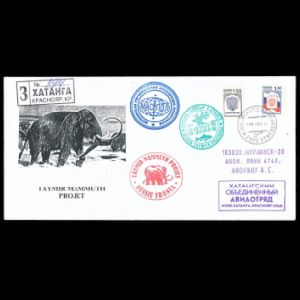 |
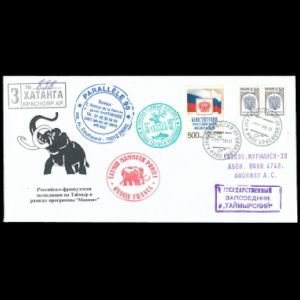 |
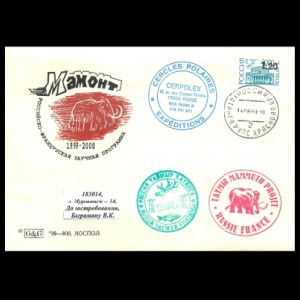 |
| 1999 "CERPOLEX Mammoth expedition" [COV1] | 2000 "CERPOLEX Mammoth expedition" [COV1] | 21.02.2005 "EXPO 2005 in Japan" [COV3] |
 |
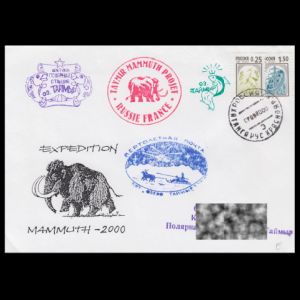 |
 |
| 2008 "Mammoth expedition" [COV2] | ||
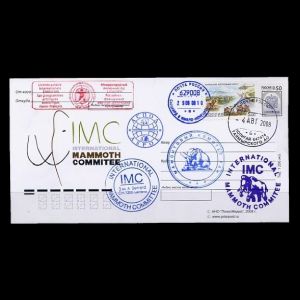 |
|
|
Notes:
[COV1] Commemorative covers were produced by the Polar Post club (http://www.polarpost.ru/) on occasion of Russian-Fench CERPOLEX/Mammuthus Expeditions on the Taimyr Peninsula, Arctic Siberia, Russian Federation.
[COV2] Commemorative cover was produced by the Polar Post club.
[COV3] One of the main attraction of the EXPO'2005 in Japan was a skull of Mammoth from Siberia, Russia.
The Russian post issues a Souvenir Sheet "Wisdom of nature" and a commemorative postmark for the EXPO'2005.
According to the official press release,
the theme of Russia’s participation in EXPO 2005 shall be “The Harmony of Noosphere”.
The stamp depicts an emblem of the Russian layout honoring the harmony of noosphere, a tree as a symbol of life and the universe.
The margin of the souvenir sheet bears the Mendeleyev periodical table of elements, the Saviour icon by A. Rublev and a
reproduction of Leonardo da Vinci’s the vitruvial man (the planning of temples) as well."
The Mammoth image taken from the Soviet cartoon "Mom for a mammoth" (1981).
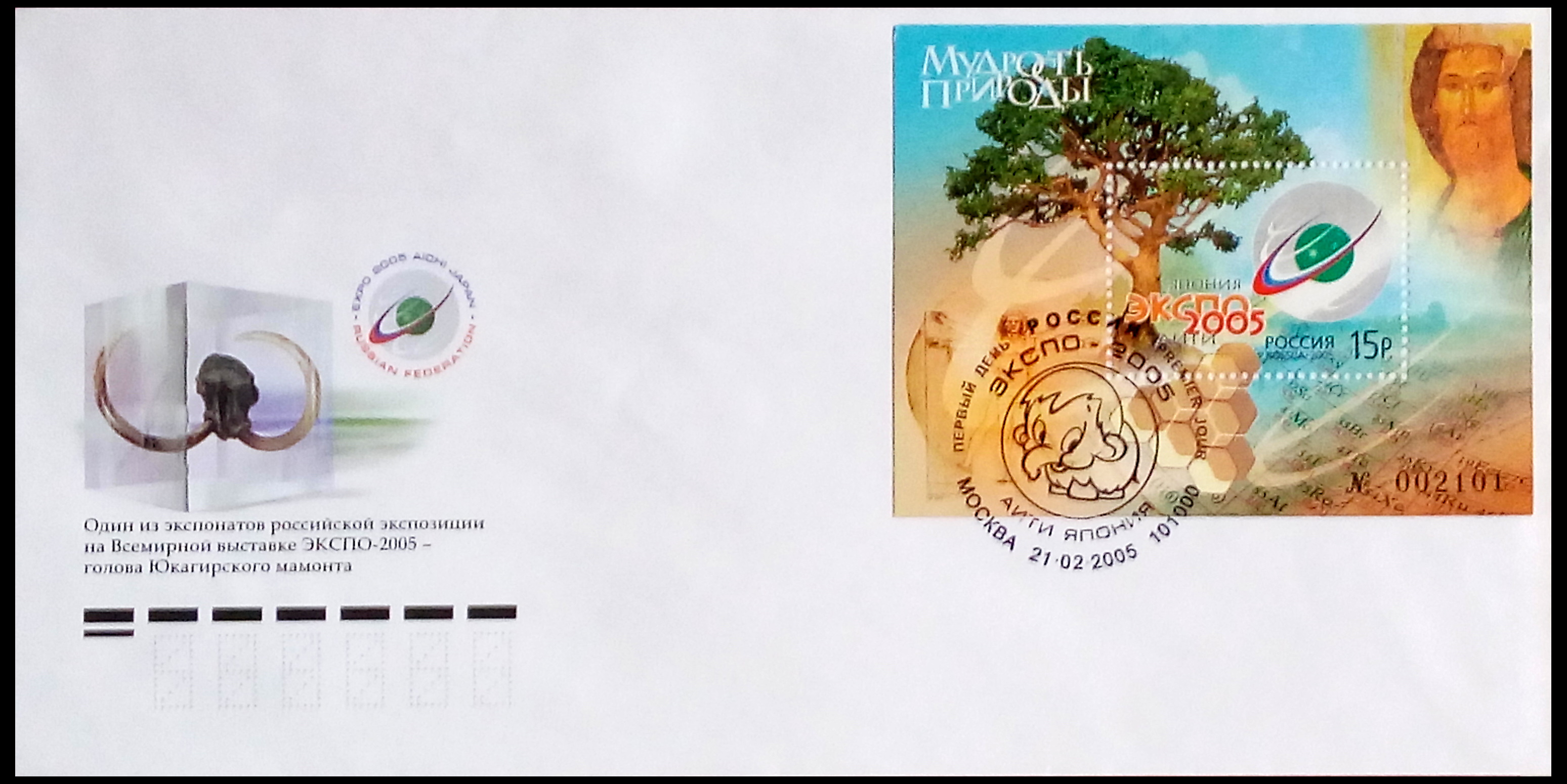 |
|
| Commemorative cover of Russia 2005 - EXPO 2005 in Japan | The Soviet cartoon - "Mom for a mammoth" (1981). |
Commemorative covers of Russia to consider: Natural History Museums
| 23.06.2005 "750th anniversary of Kaliningrad" [A1] | "Official cover of Paleontological Museum in Moscow " | |
 |
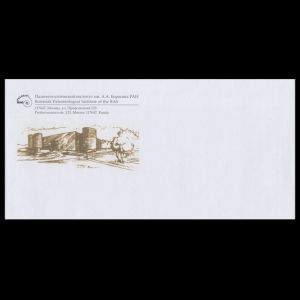 |
|
Commemorative postmarks of Russia related to Paleontology: prehistoric animals
Legend is here| 02.03.1994 "100th anniversary of A.N. Oparin" [Sp] [PS1] | 26.11.2002 "City day of Kuorat Kunai, Yakutsk" [Sp] [PSO1] | 01.01.2007 "175th anniversary of Zoological Institute of Russian Science Academy in St. Petersburg" [PM] [PM1] | |
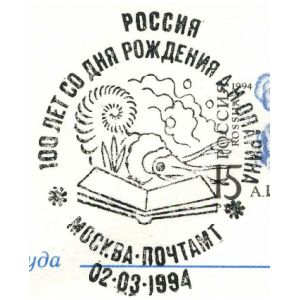 |
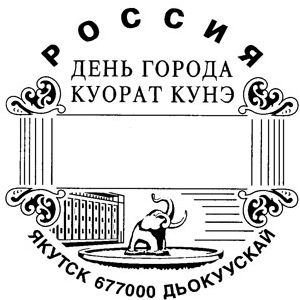 |
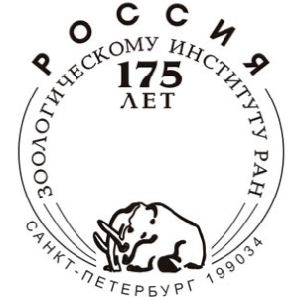 |
|
| 14.07.2011 "270th anniversary of Peter Simon Pallas" [Sp] [PS4] | 16.09.2016 "275th anniversary of Peter Simon Pallas" [Sp] [PS4] |
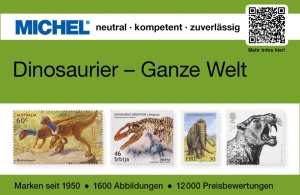
|
|
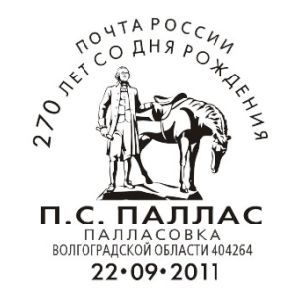 |
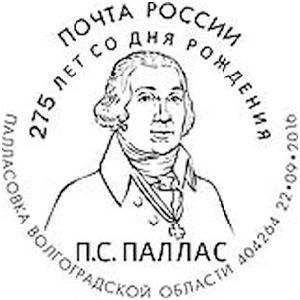 |
||
| 29.11.2017 "175th anniversary of P.A.Kropotkin" [Sp] [PS3] | |||
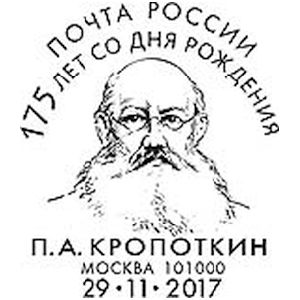 |
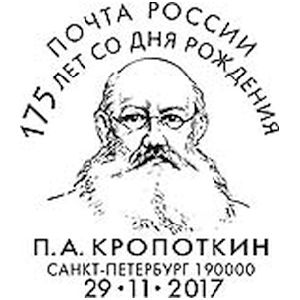 |
||
| 03.06.2020 "Paleontologic Heritage of Russia" [FDC] [1] (Moscow, St. Petersburg, Orenburg) |
|||
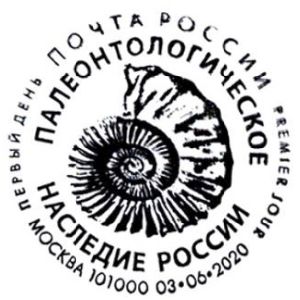 |
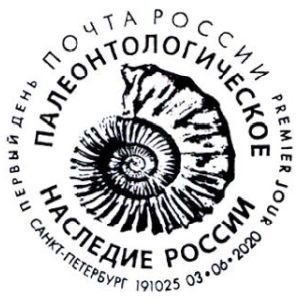 |
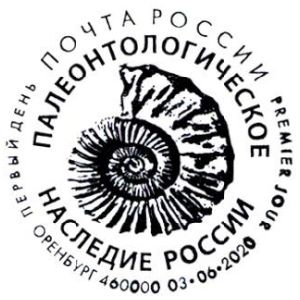 |
|
| 03.06.2020 "Paleontologic Heritage of Russia"
[FDC] [1] (Saratov, Yaroslavl, Sevastopol [PM2]) |
|||
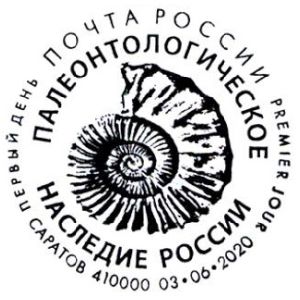 |
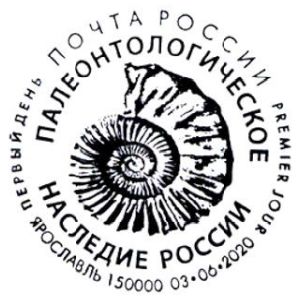 |
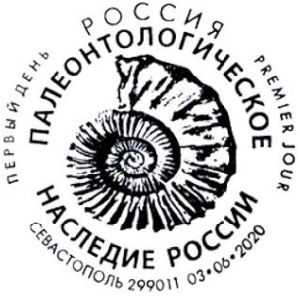 |
|
| 17.02.2023 "Fauna of Russia. Mammoth fauna" [Boycott Russia] PM3 | |||
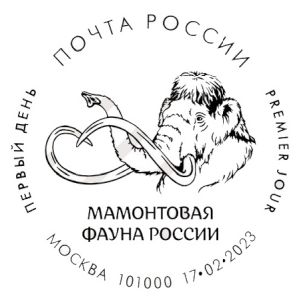 |
|
||
Notes:
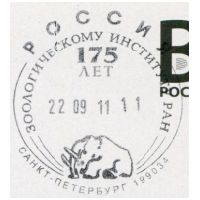
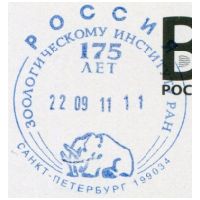
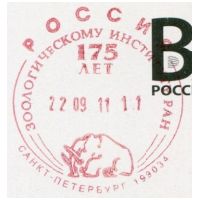 [PM1] Once introduced in 2007 for 175th anniversary of
Zoological Institute of Russian Science Academy in St. Petersburg [PSO3],
this postmark was in use, probably even in use to date, and exist in several color variations
[PM1] Once introduced in 2007 for 175th anniversary of
Zoological Institute of Russian Science Academy in St. Petersburg [PSO3],
this postmark was in use, probably even in use to date, and exist in several color variations[PM2] Sevastopol is the largest city on the Crimean Peninsula and a major Black Sea port. Since annexing Crimea in 2014, the Russian Federation has administered Sevastopol as a federal city.
Nevertheless, Ukraine and most of the UN member countries continue to regard Sevastopol as a city with special status within Ukraine. [R10]
[PM3] There 11 FDC's postmarks issued by the Russian Post - the same design, but different cities.
Other commemorative postmarks of Russia to consider: Natural History Museums
Legend is here| 21.02.2005 "EXPO'2005 in Japan' [FDC] [COV3] | 20-30.04.2006 "320th anniversary of Vasily Nikitich Tatishchev (1686-1750)" [Sp] [USSR-O4] | 29-31.01.2007 "125th anniversary of AP Karpinsky Russian Geological Research Institute" [Sp] [PSO3] |
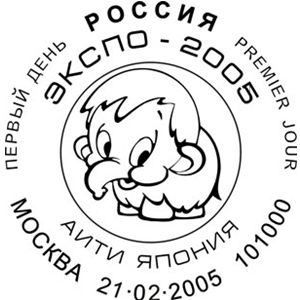 |
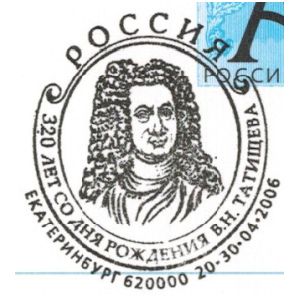 |
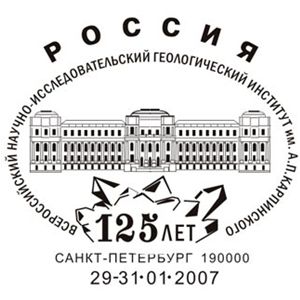 |
10.10.2013 "150th anniversary of V.A. Obruchev" [Sp] [PSO5] | 18.08.2014 "300th anniversary of Kunstkamera" [Sp] [PSO6] |
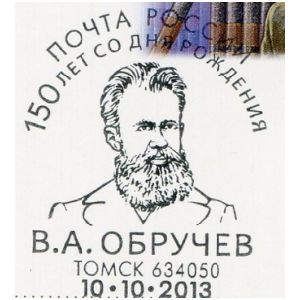 |
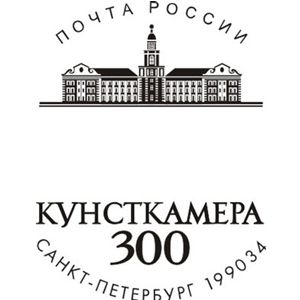 |
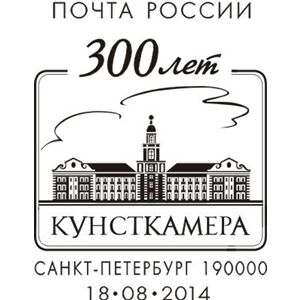 |
| 10.02.2015 "Lena Pillars Nature Park" (Moscow and Yakutsk) [FDC] [A3] | ||
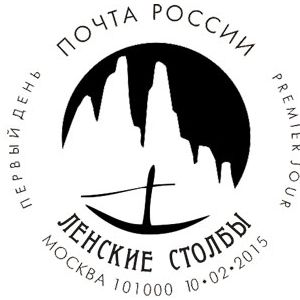 |
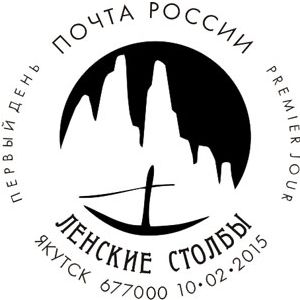 |
|
References:
- [R1] Russia:
Wikipedia,
WikiTravel,
Flag Counter
- [R2] Postal History and Philately of Russia:
Wikipedia,
Links to official website of the Post Authority, stamp catalog and a list of new stamps of Russia are here,
Russian federation counterfeit illegal stamps (has a huge number of images so please be patient with downloading the page). - [R3] Alexander Oparin: Wikipedia.
- [R4] Kropotkin Pyotr Alekseyevich: hpsrepository.asu.edu.
- [R5] Permafrost Research Institute in Yakutsk: official website, Wikipedia.
- [R6] Paleontological Society of Russia: Official website of "AP Karpinsky Russian Geological Research Institute".
- [R7] Zoological Museum of the Zoological Institute of the Russian Academy of Sciences: official website, Wikipedia.
- [R8] Vladimir Afanasyevich Obruchev: Wikipedia,
- [R9] Kunstkamera: official website, Wikipedia.
- [R10] Sevastopol: Wikipedia
- [R11] Lena Pillars: Wikipedia.
- [R12] Kaliningrad Regional Amber Museum: Wikipedia,
- [R13] Stanley Miller: Wikipedia.
- [R14] Alexander Karpinsky: Wikipedia,
- [R15] Peter Simon Pallas: Wikipedia,
- [R16] Simbircite: Kopiewski, Museum-Salon Stone Simbirtcite, mineralienatlas, jewellery.org.ua, cottonwoodsls.com.
- [R17] Karl Maksimovich Baer: Wikipedia.
- [R18] Helicoprion: Wikipedia.
- [R19] Perm and Permian Period:
- Perm city: Wikipedia.
- Permian Period : Wikipedia, Encyclopedia Britannica,
- [R20] Lore Museum of Perm city: official website, Permian branch of the Museum,
Acknowledgements:
- Many thanks to Dr. Peter Voice from Department of Geological and Environmental Sciences, Western Michigan University, for the draft page review and his valuable comments.
- Many thanks to fellow collectors Mr. Andrey Enyashin and Mr. Alexander Pedchenko from Russia for their comments and help finding some missing postal stationeries and postmarks.
- Many thanks to fellow collector Peter Brandhuber from Germany for his help finding some missing postmarks.
- Many thanks to fellow collector Maxim Romashchenko from Canada for his help finding some missing stamps.
| << previous country | back to index | next country >> |

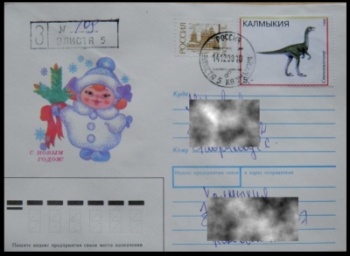
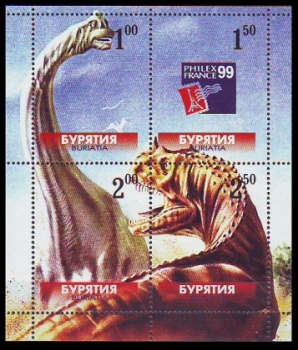
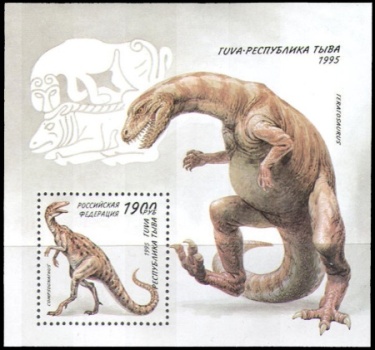
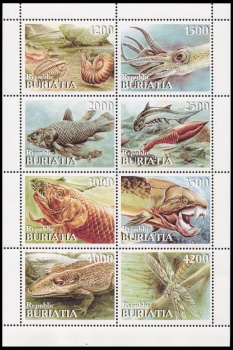
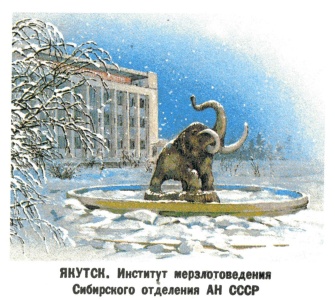
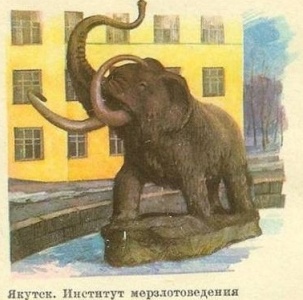

 On the left:
Mammoth sculpture from Yakutsk on the cachet's background
of Russian postal stationeries "VI Children of Asia International Sports Games" from 2006.
On the left:
Mammoth sculpture from Yakutsk on the cachet's background
of Russian postal stationeries "VI Children of Asia International Sports Games" from 2006.
